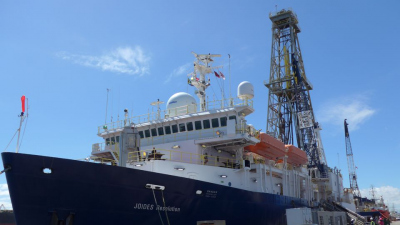- Home
- Discover
- Archive News
- News 2022
- Researchers take long cores from the Agulhas Plateau for the first time
Researchers take long cores from the Agulhas Plateau for the first time
The Agulhas Plateau is a large oceanic plateau that lies approximately 500 kilometers south of South Africa. It is hypothesized to be the remains of a large-scale volcanic event that occurred as Gondwana broke up into Antarctica, Africa and South America, which originally formed at, or near, sea-level. The sediments laid down on top of the plateau since its formation, now more than 1km in thickness in places, record the long-term changes in paleo-climate and ocean circulation as the Earth evolved from warm, greenhouse conditions in the Cretaceous to a cooler world with polar ice sheets in the Cenozoic. IODP Expedition 392 “Agulhas Plateau Cretaceous Climate” aims to recover the first ever deep geologic samples from this area in order to both determine origin of the plateau and document evolving ocean connections and climate in the Southwest Indian Ocean over the past ~120 million years. A team of international scientists has left the port of Cape Town onboard the research drilling vessel JOIDES Resolution on 10 Feb 2022, headed for the Agulhas Plateau.
It has been suggested that significant changes in past ocean and atmospheric circulation related to evolving bathymetry in oceanic gateways drove regional and global scale climate change. One such gateway is the Africa – Southern Ocean Gateway that connects the Indian and Atlantic oceans, which opened with the formation of the Agulhas Plateau. However, incomplete sedimentary records from the southern high-latitudes make understanding Earth’s oscillatory cooling transition from the Cretaceous Hothouse (peaking at approximately 90 million years ago [Ma]) to the mid-Cenozoic Icehouse (approximately 33.7 Ma) extremely difficult – and therefore difficult to assess the relationship between climate change and gateway evolution.
The overarching motivation of Expedition 392 is to gather sediments and volcanic rocks from below the seabed to develop a greater understanding of: (1) the origin of the Agulhas Plateau and the timing of its emplacement; (2) the interplay between ocean circulation, the formation of the Agulhas Plateau as an obstruction, and changes in regional and global climate; (3) episodic climate change and the response of high-latitude marine plankton communities in greenhouse periods of Earth history; and (4) the long-term evolution of climate from the Cretaceous to the Cenozoic.
Part of the more than 30-member international research team is Dr. Thomas Westerhold from MARUM - Center for Marine Environmental Sciences at the University of Bremen. His task is to ensure that as complete a sequence of sediments as possible is drilled from the seafloor. "We still know very little from the Agulhas Plateau region. Little about its importance to regional and global climate events. And almost nothing about the climate archives on the Agulhas Plateau. This research trip is adventurous not only because of the logistics. It is also adventurous because we don't know at all what climate stories await us down there. We're entering uncharted territory, and for the first time we'll be able to obtain climate evidence from a region that is considered one of the interfaces between low-latitude and high-latitude climates."
Scientific drilling of Cretaceous records on the Agulhas Plateau will recover volcanic rocks and sediment samples that provide fundamental insight into the complex interplay between southern African climate evolution, ocean redox, nutrient development and associated organic carbon burial, and multiscale volcanic activity in the young and still small Southern Ocean basin. Its location at a high southern palaeo-latitude makes the Cretaceous archive of the Africa- Southern Ocean gateway a particularly valuable target.



